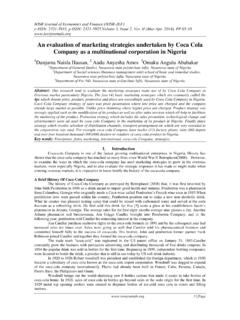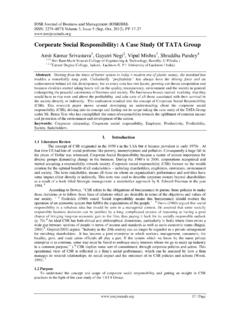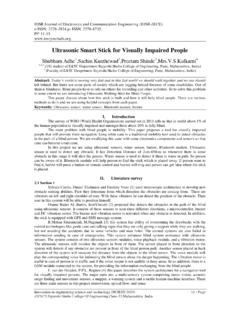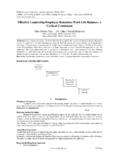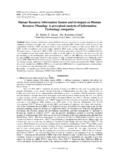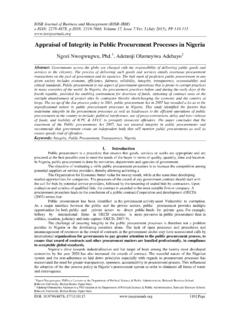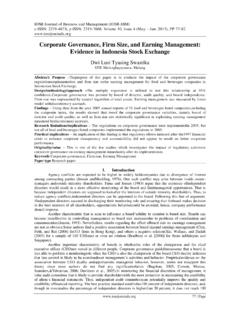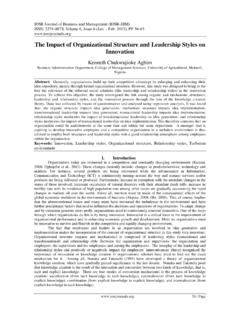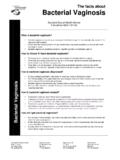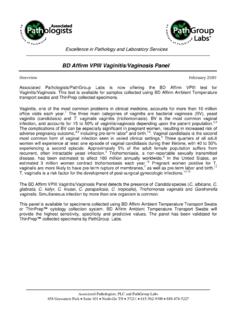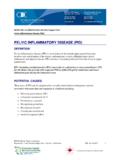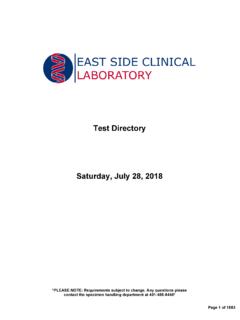Transcription of Evaluation of different diagnostic methods of …
1 IOSR Journal of Dental and Medical Sciences (IOSR-JDMS) e-ISSN: 2279-0853, p-ISSN: 2279-0861. Volume 13, Issue 1, Ver. VIII (Feb. 2014), PP 15-23 15 | Page Evaluation of different diagnostic methods of bacterial vaginosis Gamal F. M. Gad , Ahmed R. El-Adawy , Mohammed S. Mohammed3, Abobakr F. Ahmed1, Heba A. Mohamed Microbiology department, Faculty of Pharmacy, Minia University 2 Gynecology and Obstetrics department, Faculty of Medicine, Minia University 3 Microbiology department, Faculty of Medicine, Minia University Abstract: bacterial vaginosis (BV) is an ecological disorder of the vaginal microbiota that affects millions of women annually, and is associated with numerous adverse health outcomes including pre-term birth and the acquisition of sexually transmitted infections.
2 This study aimed to determine the incidence rate of bacterial vaginosis among women and examine the effect of some risk factors and demographic features on BV incidence. Also aimed to compare between the different methods of BV diagnosis. The results revealed that from the 100 patients, 33% were diagnosed as bacterial vaginosis , 23% were having candidiasis, 8% aerobic vaginitis, 3% trichomoniasis and 33% were normal. The highest number of BV positive cases was in the age group of (26-35)Yrs, 94% of the 33 BV positive cases were using vaginal douches and 94% were married.
3 BV positive cases using IUD were equal to BV positive cases using hormonal contraceptives including injection and tablets (12/33, ). BV was diagnosed in 33%, 38%, 36%, 30% and 34% of patients using Gram stain, culture, Amsel criteria, BV Blue test and qPCR respectively. When the different diagnostic methods were compared to Gram stain as a gold standard, qPCR had the highest sensitivity, accuracy and negative predictive value while BV Blue test had the highest specificity and positive predictive value. Key words: bacterial vaginosis , Nugent score, Amsel criteria, BVBlue test.
4 I. Introduction bacterial vaginosis (BV) is a polymicrobial syndrome with acquisition of several fastidious bacteria, concurrent with a decrease of lactobacilli, the dominant constituents in normal vaginal flora [1]. It is a condition characterized by replacement of vaginal lactobacilli with predominantly anaerobic micro-organisms such as Gardnerella vaginalis, Prevotella, Peptostreptococcus and Bacteroides spp. [2]. Although BV is often asymptomatic, it still is, along with vulvovaginal candidiasis, the most common cause of vaginitis, and hence among the commonest reasons for women to seek medical help [3].
5 BV is common in low social economic groups where the reported incidence is 20-49%. Its reported rate is 45-55% in African American, 20-30% in Asian women and 5-15% in Caucasian women [4]. There is an evidence that BV, whether it is asymptomatic or symptomatic, is an independent risk factor for severe reproductive tract and obstetric sequelae, including pre-term delivery, pre-term labor, low birth weight, post abortion endometritis, post-partum endometritis [5], development of Pelvic inflammatory disease (PID) as reported by [6], acquisition of sexually transmitted diseases (STIs) as proved by [7], acquisition and transmission of HIV [8].
6 Due to these serious complications, there has been an increase of interest in bacterial vaginosis during the last decade, regarding its diagnosis and treatment [9]. The diagnosis for bacterial vaginosis remained difficult and controversial due to lack of diagnostic tools. Clinically, BV can be identified by the presence of at least three of the four Amsel criteria: an elevated vaginal PH, an increased vaginal discharge, the presence of clue cells and an amine odor after the addition of potassium hydroxide [10]. Another method used to detect BV is Gram staining of vaginal smears and Evaluation of them according to Nugent scoring system which scores vaginal smaers from 0 to 10 depending on the numbers of three bacterial morphotypes observed on the slide [11,12].
7 The culture- based microbial detection method of the vaginal fluid is performed for the detection of the causative agents of intravaginal infections including bacterial vaginosis . In women with BV, Gardnerella vaginalis is almost universally present (99%) and majority have Atopobium vaginae (96%) infection [13], Culture of these two bacteria will be useful as a diagnostic tool of BV. The BV Blue Kit is a bedside rapid test kit to diagnose bacterial vaginosis . It involved the detection of vaginal fluid sialidase activity which is produced by the organism causing bacterial vaginosis .
8 BV Blue detects vaginal fluid sialidase activity at levels of U [14]. PCR-based tests are being used for molecular diagnosis of BV, mostly based upon molecular quantification of G. vaginalis and A. vaginae [15]. These two species co-occur in the large majority of BV patients, and the possibility of combining the detection of these two species for an accurate diagnosis of BV has been suggested [16, 17]. Evaluation of different diagnostic methods of bacterial vaginosis 16 | Page This study aimed to monitor the prevalence of BV among women complaining from vaginitis and excessive vaginal discharge and Evaluation of the different commonly used methods of BV diagnosis including Amsel criteria, culture, BVBlue test and quantitative real time PCR, regarding their sensitivity, specificity, positive predictive value.
9 Negative predictive value and accuracy using Gram stain with Nugent score as a gold standard. II. Material and methods Patients: The study was carried out on one hundred patients attending family planning clinic at Minia University hospital for obstetrics and gynecology, Minia, Egypt during the period between June 2012 to June 2013. A total of 500 vaginal swabs (five swabs for each patient) and 100 vaginal lavage were taken from 100 patients complaining from symptoms of vaginitis or excessive vaginal discharge. The patients included in this study were in the age range from (18-45) years.
10 Patients were subjected to questionnaire including demographic data like age, marital status and pregnancy. They were asked about their presenting complaints, contraceptive use, menstrual history, previous episodes of vaginal infections, last sexual intercourse, medical history, history of using vaginal douches or any vaginal preparations and history of taking any antimicrobial agents either systemic or vaginal. All patients were examined using speculum without lubrication and the presence of vaginal erythema and vaginal discharge was recorded with description of the color, consistency and odor of discharge.
